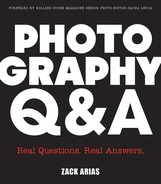Exposure drills.
Q: WHAT DRILLS WOULD YOU GIVE YOURSELF TO REALLY DRIVE HOME EXPOSURE SO WELL THAT IT’S LIKE BREATHING? I FEEL LIKE I’M TRYING HARD, BUT IT’S NOT SETTING IN. I GET NERVOUS, I FORGET. I HATE IT!
A: Simplify. Simplify. Simplify.
Exposure is made with a combination of shutter speed, aperture, and ISO. That’s it. Well, except when we introduce flash. Don’t worry about that yet. Shutter. Aperture. ISO. That’s it. Every scene in front of you will require X aperture @ Y shutter speed @ Z ISO.
Head out the door for an hour and shoot at ISO 200 at f4. You’ve now locked down two out of three exposure variables. All you have to figure out with your in-camera meter is shutter speed. Don’t change ISO. Don’t change aperture. Just shutter speed. Remember your camera wants to meter and make everything 18% grey. Average metering is reading everything. Spot metering reads just the middle (or it may follow your AF point. RTFM for that one). Set your camera to average metering and go shoot.
Look at the subject. Is it 18% grey? Close? Maybe darker? Maybe lighter? Solid green grass is about 18% grey. A good, deep, blue-sky color is about 18% grey. A strong red can be about 18% grey. You have to learn what is “grey” and what is not so you can anticipate what your meter is “thinking.”
Head out the next day at ISO 200 at 1/60th of a second shutter speed and figure out aperture only. You’ll learn the limits of your lens pretty quickly. Then go out with f5.6 at 1/250th of a second and just change ISO.
Get really comfortable changing one thing at a time. Once you find confidence doing this you’ll start being able to move two things at once. Then you’ll be thinking in exposure. You’ll be trying to read it before you even pull the camera to your eye.
What worries me most in your question is your statement, “I get nervous.”
Don’t get nervous. It’s just stuff. There isn’t a starving tiger about to be released on you if you get it wrong. Yes, it’s a lot to learn but all you need is discipline to learn exposure. As you begin to learn exposure you will take the most boring photos of your life. That’s fine. Someone learning to play the piano isn’t writing the lost Mozart concerto. They’re just playing scales and notes. Playing the piano and writing songs are two different things. Learn to play. Once you have that down, then you’ll start to write. Just don’t be nervous about it. Have fun.
Wax on. Wax off.
The meter inside of your camera wants to make the world 18% grey. Pictured here is a basic exposure target that has black, 18% grey, and white on it. A good base exposure will yield each value correctly. There should be a little detail visible in the black and white areas.

If you put your spot meter on the black area and take a shot at the displayed settings, then the camera is trying to make black into grey and will overexpose the photo.

Your meter wants to make things 18% grey, so you should get an acceptable exposure value by spot metering this area of the target.

When a meter reads white and tries to make it grey, it will underexpose the image. Setting your camera meter to a multi mode or average metering mode will make the camera take readings from several areas of your frame and then average all of those readings together. If there is one thing you should read in your camera manual, it is the area on the different metering modes it has, how they work, and how to access them.

